Traditions & Techniques in Knit & Crochet: Summer 2023 SDJ, Out Now!
July 17, 2023
Surface Design Association is excited to announce Traditions & Techniques in Knit & Crochet, our Summer 2023 edition of Surface Design Journal. “Knitting and crochet seem to be everywhere these days. There are myriad artists on social media and no shortage of how-to videos on YouTube. Flip the pages of fashion magazines or take a walk down the runway to find couture versions of grandmom’s favorite hand-made sweater. Big box stores are full of ready- to-wear collections including crocheted bags and dresses with a 70’s vibe. Even the hallowed halls of art museums are finally embracing knit and crochet artists. Popular culture has apparently “discovered” what we’ve known all along: the allure (some might say obsession) of age-old traditions and techniques for knitting and crochet.” – Elizabeth Kozlowski, Surface Design Journal Editor
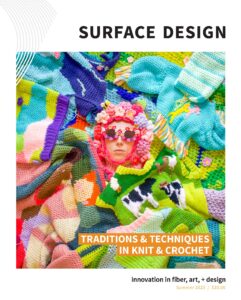
Here’s a preview of what you’ll discover:
“Mulyana’s Modular Utopia: Envisioning a Sustainable Future: by John Silvis: “Mulyana describes the act of knitting and crocheting as a form of meditation and prayer. He describes his artistic expression as ‘a privilege to show gratitude to the Creator who has blessed me with a sound mind and a healthy body for my life on earth.’”
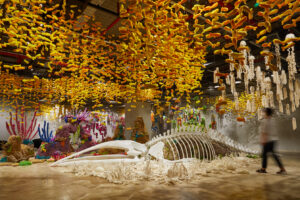
Mulyana, Into The Abyss, 2021. Crocheted yarn, cable wire, felt, dacron and plastic net, with resin, metal structure and fur fabric. Part of Cheongju Craft Biennale, South Korea. Courtesy of Sapar Contemporary and the Artist.
“Wharenui Harikoa: Lissy Robinson-Cole and Rudi Robinson” by Dr. Pounamu Jade William Emery Aikman: “Lissy and Rudi describe their textured sculpture as ‘a refractive prism of tūpuna-inspired light,’ one which, in hushed darkness, comes sharply into view. Like the spectrum of colour unleashed as white light passes such a prism, ‘Wharenui Harikoa” is illuminated by purpose in abundance.”
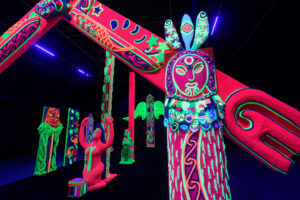
Lissy Robinson-Cole (Ngāti Hine, Ngāti Kahu) & Rudi Robinson (Ngaruahine, Te Arawa, Ngāti Pāoa, Waikato ki Tai), Wharenui Harikoa (interior), 2022. Crocheted New Zealand neon wool on carved polystyrene, 13 x 16.75 x 310.5 feet installation. Photo: Nick Taylor, the Dowse Art Museum, Aotearoa New Zealand.
“Knitting Architecture” by Dr. Jenny Underwood & Dr. Leanne Zilka: “Knitting Architecture is a series of projects that have come out of a collaborative research practice we developed over several years. By bringing together textile design, architecture, and materials research in colourful and playful ways, our practice explores innovative approaches to creating textile- based solutions that improve our built environment.”
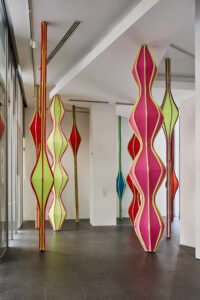
Jenny Underwood & Leanne Zilka, Knitted Installation (installation), 2022. Machine-knit, 13.3 x 20 inches. Photo: Peter Bennets.
“(Un)Permeable Body: The Work of Leif Holmstrand” by matt lambert: “Nets and net-like structures exist throughout Holmstrand’s work, as industrial netting, crochet, knitting and kinbaku and shibari rope knotting. Some are meticulous, others haphazard. I found myself traveling piece by piece, trying to decipher techniques and determine what was machine-made and what was handmade. It’s clear the artist is making choices about when to deploy refinement and when to lean into intuitive or slapdash techniques.”
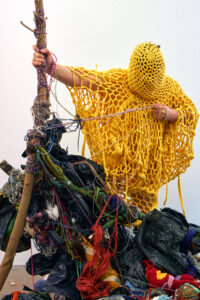
Leif Holmstrand, Three Lovers, 2020. Performed at Galleri 54, Gothenburg, Sweden. Photo: Grzegorz Fitał.
“Radical Crocheting & Knitting in Contemporary Indigenous Art” by Dr. Manuela Well-Off-Man: “While the origins of crochet are somewhat blurry, most researchers agree that the history of knitting began in the Middle East in the 5th century and then spread in Europe. Native Americans started using both fiber artforms during the early 19th century, when European settlers introduced crochet and knitting in the United States. One hundred eighty years later contemporary Indigenous artists such as Cannupa Hanska Luger (Mandan, Hidatsa, Arikara, Lakota), Maggie Thompson (Fond du Lac Ojibwe), Eleng Luluan (Rukai), and others incorporate crocheting and knitting in their works in unexpected ways.”
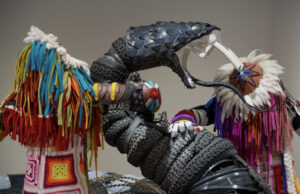
Cannupa Hanska Luger, This Is Not A Snake / The One Who Checks & The One Who Balances (detail), 2017–2020. Ceramic, riot gear, fiber, steel, oil drums, concertina wire, ammunition cans, trash, found objects, beadwork, surplus industrial felt and afghan, 6.5 x 3 x 50 feet. Photo: Craig Smith; courtesy of Heard Museum.
In The Studio: “The Invisible World” by Ingrid Schmidt: “My knitting project ‘Lake Geneva Bestiarium,’ realized in the form of brooches, captures the world of microscopic and organic growth patterns of an invisible life in water. My focus for this endeavor is to create awareness of the beauty and fragility of nature, even when not visible to the naked eye.”
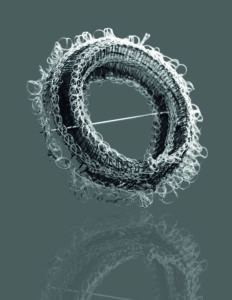
Ingrid Schmidt, Bestarium 2, 2015. Knitted nylon, black lacquered copper wire and silver 925, 2.2 x 1.2 inches. Photo by the artist.
In The Studio: “Studio Practice As A Reflection Of Physical Space” by Françoise Danoy: “Along with developing my skills as a knitwear designer, I focused on documenting and sharing my journey of connecting to my cultural heritage. Specifically, I explored the complexities of living in the Māori diaspora and the various ways in which one can connect to their culture. For example, I translated traditional geometric motifs such as tāniko into color-work charts and used intricate lace and twisted stitches to represent these themes and concepts in a more abstract way. Narrowing my focus and working in a limited space helped me become more intentional in my creative practice, allowing me to explore my cultural heritage more deeply.”
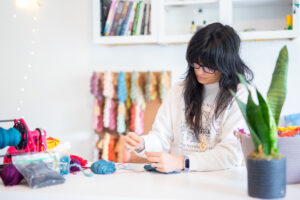
Françoise Danoy knitting in their studio, 2023.
In The Studio: “Knitwear Designer Graphic Text” by Kendall Ross: “After graduating, I started to work full-time as a fiber artist under my artist and brand name, I’d Knit That. I obviously didn’t go to art school, but once I started knitting, I never stopped. Like my mom, grandma, and aunts, I have always appreciated the process of making something from nothing. There isn’t a better feeling than having a vision in your mind of what you want to create and being able to use your hands to execute it out of two needles and string. It feels like the need to create is in my DNA.”
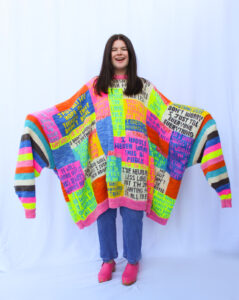
Kendall Ross, I would never wear this in public, 2022. Hand-knit wool yarn, 60 x 50 inches. Currently at Factory Obscura in Oklahoma City, US. Photo by the artist.
Informed Source: “Exploring Nature Through Color” by Anna Bauer & Eva Zethraeus: “In Sweden we follow an old law called Allemansrätten, which is the right to walk around freely in the woods, pick berries, flowers and mushrooms, even if the land is privately owned, provided one respects nature. Norway, Finland, Estonia and Iceland all have similar laws. This makes it possible for everyone to enjoy what nature has to offer.”
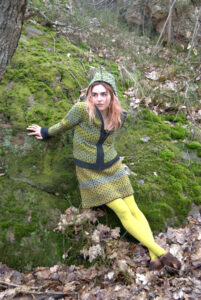
Eva Zethraeus (designer), Hand-knit green hoodie and skirt, 2020. Plant dyed yarn from birch leaves, red onion peel and water reeds. Photo: Eva Zethraeus.
Made Aware: “BIPOC In Fiber” by Jeanette Sloan: “I never saw myself as an activist before BIPOC in Fiber. In fact, when asked what I did, my first response was a knitwear/ textile designer, maker and writer. I’ve worked with textiles in one guise or another since graduating from university in 1990. Having studied textile design with a specialty in knitting, my work has explored both hand and machine processes while embracing embellishing techniques like embroidery and beading.”
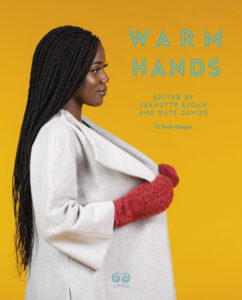
Warm Hands (cover), co-edited by Jeanette Sloan and Kate Davies.
First Person: “Environmental Activism through Knitting” by Eve Jacobs-Carnahan: “My narrative sculptures illustrate destabilizing weaknesses in American democracy. I illuminate factors undermining our electoral system by telling stories with birds cloaked in soft yarn. Humorous fluffy bouclé chickens, watchful herons in feather-textured green and blue garb, and elegant gulls decked out in lace stand in for human characters. They are relatable and yet, far enough removed to provide emotional distance.”
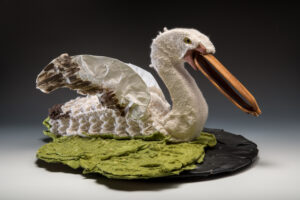
Eve Jacobs-Carnahan, Trawling the Algae Overload, 2017. Knitted and felted wool yarn, mulberry paper, rubber inner tubes, corn on the cob tray, rigid foam, canvas, wire, plywood, acrylic paint, gel medium and hardware, 13 x 28 x 22 inches. Photo: Paul Rogers Photography.
First Person: “Knotted Neon” by Aynsley Grealis: “I am drawn to crochet as a sustainable alternative to fast fashion. Additionally, crochet can only be worked by hand, therefore, as a crochet artist, I put all of myself into each piece, one stitch at a time. I work with all types of fibers, ranging from cotton and acrylic to wool and mohair. However, I try to use natural fibers whenever possible. For more structured pieces, such as my embellished balaclavas, I gravitate towards acrylic and cotton due to the wide range of colors and their ability to hold shape.”
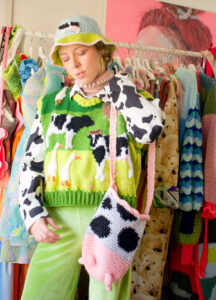
Aynsley Grealis, Barn Yarn Vest, 2023. Knitted acrylic yarn. Photo: Marco Beertuzzo.
To buy a copy of Traditions & Techniques in Knit & Crochet, go to the SDA Marketplace, or you can check out a free digital sample on our SDA Journal page.
